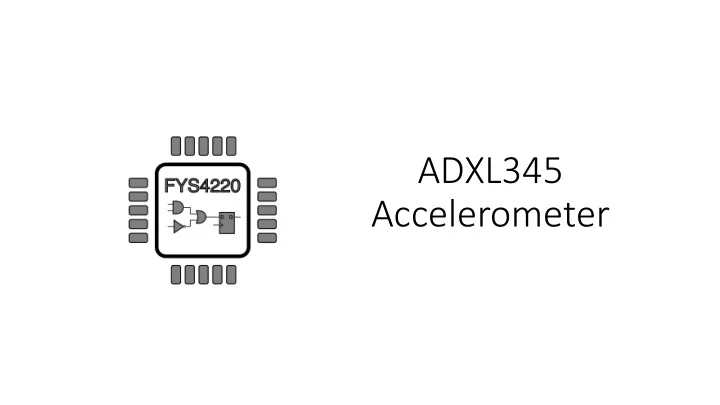

ADXL345 Accelerometer
Accelerometer • Measures acceleration (rate of change of velocity) of a body in its own rest frame* • An accelerometer at rest on the surface of the Earth will measure an acceleration due to the Earth’s gravity, straight upwards of g=9.81 m/s 2 • By contrast, accelerometers in free fall (falling toward the center of the Earth) will measure zero. Fixed plates MASS Acceleration C1 g C2 To obtain the acceleration due to motion with respect to the earth, the “gravity offset” must be subtracted. Spring *Coordinate system (frame of reference) in which the body is at rest
• 3-axis accelerometer • ±2g, ±4g, ±8g, ±16g • 13-bit resolution (@ ±16 g) • Supports both I2C & SPI • Built in functionality • Activity, inactivity sensing • Single and double tap sensing • Free-fall sensing • 3 mm x 5 mm x 1 mm package https://www.analog.com/en/products/adxl345.html
Output voltage increases when accelerated along the sensitive axis
I2C -mode
Read device ID register to make sure that the communication with the ADXL345 is working read_from_i2c_device(0x53,0x0,1,&data);
write_to_i2c_device(0x53,0x2d,1,0x8);
alt_u8 set_accel_config = 0x20 | 0x8 | 0x1; write_to_i2c_device(0x53,0x31,1,set_accel_config);
Register 0x32 to Register 0x37—DATAX0, DATAX1, DATAY0, DATAY1, DATAZ0, DATAZ1 (Read Only) These six bytes (Register 0x32 to Register 0x37) are eight bits each and hold the output data for each axis. Register 0x32 and Register 0x33 hold the output data for the x-axis, Register 0x34 and Register 0x35 hold alt_u8 data[6] ={0}; the output data for the y-axis, and Register 0x36 and Register 0x37 hold the output data for the z-axis. read_from_i2c_device(0x53,0x32,6,&data[0]); The output data is twos complement, with DATAx0 as the least significant byte and DATAx1 as the most significant byte, where x represent X, Y, or Z. The DATA_FORMAT register (Address 0x31) controls the format of the data. It is recommended that a multiple-byte read of all registers be performed to prevent a change in data between reads of sequential registers.
Resolution & sensitivity Table 1 in datasheet
Resolution & sensitivity Full resolution Sensitivity ±2g à 10-bit (2 10 = 1024) 4g / 1024 = 0.0039 g/LSB ±4g à 11-bit (2 11 = 2048) 8g / 2048 = 0.0039 g/LSB ±8g à 12-bit (2 12 = 4096) 16g / 4096 = 0.0039 g/LSB ±16g à 13-bit (2 13 = 8192) 32g / 8192 = 0.0039 g/LSB 1g / 256 = 0.0039 g/LSB
Preparing the output alt_16 ax, ay, az; float axf, ayf, azf; float scale = 1.0/256 // 1g/LSB alt_u8 data[6] ={0}; read_from_i2c_device(0x53,0x32,6,&data[0]); ax = (alt_16) ( data[1] << 8 | data[0] ); ay = (alt_16) ( data[3] << 8 | data[2] ); az = (alt_16) ( data[5] << 8 | data[4] ); axf = ax * scale; ayf = ay * scale; azf = az * scale;
What to expect DE10-Lite placed on table alt_u16 alt_16 float
Recommend
More recommend